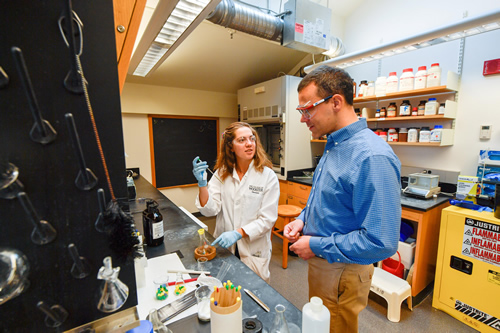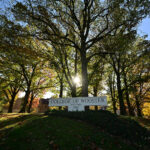
Wooster Selected as Recipient of $350,000 NMR Spectrometer from National Science Foundation

WOOSTER, Ohio – The College of Wooster will soon be acquiring a Nuclear Magnetic Resonance (NMR) spectrometer, via a grant from the National Science Foundation totaling about $350,000, to sustain its excellence in undergraduate research within the department of chemistry.
“This is a big deal. It will be used by almost every faculty member in the department, primarily for research but part of teaching as well,” said Paul Bonvallet, the principal investigator of the grant and associate professor of chemistry at Wooster. “One of the nice things about having a research-grade instrument is that we can have students operate the instrument as well. They’re getting real data from their experiments, which is the same you would get at a graduate research lab.”
An NMR is one of the most powerful tools available to chemists, especially for organic chemistry, as it uses strong magnetic fields to determine the structure of chemical compounds. This particular instrument is equipped with a broadband probe and can be used to identify unknown substances, to characterize specific arrangements of atoms within molecules, and to study the dynamics of interactions between molecules.
“There’s just no better way to know the structure of compounds,” simplified Bonvallet. “The NMR measures a process in the nucleus of the atom and can determine what part of a structure it comes from.”
The NMR, expected to arrive in the summer of 2017, will get a lot of use at Wooster from classroom to faculty research to Independent Study projects by seniors. It is replacing an older unit that served over a thousand undergraduate and faculty users, according to Bonvallet.
“It will be used to show the identity and purity of what you’ve made. Scientific journals always ask for NMR data. It’s a requirement for publication,” explained Bonvallet, who was joined by colleagues Judith Amburgey-Peters, Spring Knapp, Mark Snider, and Sarah Sobeck as co-principal investigators on the grant. “The fact that it’s the same kind of instrument you would find in a graduate lab feeds into Wooster’s broader mission.”
Faculty members will use the NMR on a wide range of research projects, from the encapsulation of environmental contaminants to exploring biological systems and improving the efficiency of materials like chemical catalysts and the UV absorbers found in sunscreens.
The College of Wooster is America’s premier college for mentored undergraduate research. By working one-on-one with a faculty adviser to conceive, organize, and complete an original research project, written work, performance or art exhibit, every Wooster student develops independent judgment, analytical ability, creativity, project-management and time-management skills, and strong written and oral communication skills. Founded in 1866, the college enrolls approximately 2,000 students.
Image: Associate professor of chemistry Paul Bonvallet (right) is thrilled to have a research-grade spectrometer on the way, which will be utilized frequently by students, like current senior Leandra Forte (left).
Posted in Faculty, News on October 12, 2016.
Related Posts
Related Areas of Study
Chemistry
Access to labs, research opportunities, and small classes give chemistry majors lots of options after graduation.
Major Minor

